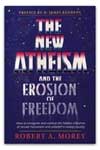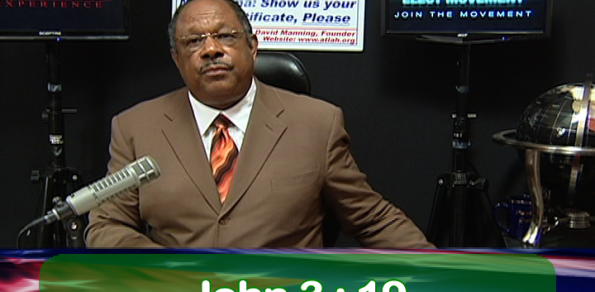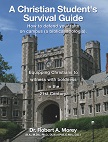Roman Catholicism Today
By Dr. Robert A. Morey
Introduction
What was the Reformation all about? What was so terrible with the Roman Catholic Church that the Protestant Reformers went off and started their own churches? Why did they protest, and what did they protest?
Today as never before there is a growing feeling among many mainline Protestants that the time has come Roman Catholics and Protestants to unite into one church. This is the goal of the National Council of Churches (NCC) and the World Council of Churches (WCC). To see this happen, things must be done.
First, the history of the Reformation must be rewritten:
1. to omit any reference to the three million Protestants killed by torture during the Inquisition run by Jesuits
2. to omit any reference to the millions who died during the Thirty Years War
3. to describe the Reformers as crazy and as villains
4. to remake Romanist villains into heroes or martyrs, such as the recent rewrite of history to clear “Bloody Mary” of her crimes
Second, the issues which created the Reformation must be:
1. completely excluded and never studied even in seminary
2. downplayed as unimportant
3. viewed as resolved because the Church of Rome has supposedly changed
In reality, the issues are still important enough to make any union with the Church of Rome impossible. Furthermore, the WCC not only wants all Protestant and Catholic Churches to unite into one super-church, but they want to form all religions into a one-world religion! This is a direct fulfillment of Bible prophecy that in the last days when the false prophet and the anti-Christ will rule the world, there will be a one-world religion as well as one-world government. It is for this reason that evangelical Christians do not join the NCC or the WCC. In this light, it is important to remember why we are Reformed and not Roman Catholics.
The Essential Issues Between Catholics and Protestants
Issue No. 1
The Roman Catholic Church is structured according to O.T. Judaism instead of N.T. Christianity.
Old Testament Judaism |
Roman Catholicism |
1. The High Priest |
The Pope |
2. Jewish Priests |
Catholic Priests |
3. Continuous Sacrifices |
Continuous Sacrifices |
4. The Temple |
The Cathedral |
5. The Holy City |
The Holy City |
6. Physical Discipline |
Physical Discipline |
7. Passive Laity |
Passive Laity |
8. Under Law/Good Works |
Under Law/Good Works |
9. O.T. Worship with incense, altar, etc. |
Worship with incense, altars, etc. |
10. Church/State As One |
Church/State As One |
Why should we continue to follow an old covenant of law/works when Christ has established a New Covenant of grace/faith? The book of Hebrews tells us that the Old Covenant with its priesthood, altars, ceremonies, sacrifices, etc., have all been fulfilled in the work of Christ. Hence they are forever gone.
Issue No. 2
The Issue of Religious Authority
The central burning issue that divides the Reformed from the Romanist is the issue of religious authority; i.e., what is the final court of appeal and the ultimate judge of truth, justice and morals? This is where the line is drawn with every cult. In a cult, the leadership always views itself as having equal or greater authority than the Bible. On this basis, we must conclude that the Church of Rome is a cult.
Now we recognize that some people do not view the Church of Rome as a cult because of its size and age. But the size or age of a religion cannot erase the fact of it being a cult if its authority structure is cultic.
To put it simply, the Church of Rome is the oldest and the biggest “super-cult” of all time. It has killed multiple millions—more than the Christian Scientists, Mormons, Jehovah’s Witnesses, Hare Krishnas, Jim Jones and all the killer cults put together. It has burned more Bibles, destroyed more Protestant churches, and murdered more Gospel preachers than the Communists! For a thousand years it succeeded in burying the Gospel under a mountain of false doctrines and superstitious ceremonies. If it were not for the brave men and women of the Reformation, we might still be in bondage to the Church of Rome.
The following diagram contracts the Romanist and Reformed views of authority.
Religious Authority |
|
Romanist |
Reformed |
1. The Church: |
The Bible is the only and final authority in all matters of faith |
2. The Bible |
|
The Chief Problem: The Claim of Infallibility
While the Church of Rome has changed some of the minor details of its ceremonies, its doctrines have not changed since the Council of Trent (1545 to 1563). Indeed, the Roman Church cannot change its doctrines because it claims to be infallible in doctrine. Thus, if it ever admitted that is was at any time wrong on any doctrine, it could no longer claim to be infallible!
Since Romanists base their faith on the infallibility of the Pope and the Church, no one can doubt or question Catholic dogma. While the Bible is mentioned as being one of the sources for its authority, the Roman Church is actually the only and final authority because it will allow only its interpretation of Scripture. Thus, when a doctrine is in conflict with Scripture, the Scripture is conformed to the doctrine!
True Religious Authority
Principle No. 1: There can be only one ultimate final authority.
The attempt to have two, three or more “final” authorities is impossible. Ultimately one will win out over the others. Just as there can be only one captain of the ship or one head of the home, even so there is only enough room in this universe for One Final authority (Matt. 6:24).
Principle No. 2: God is this one ultimate final authority. God has authority over all of life because He is the Creator and Sustainer of all things (Matt. 28:18).
Principle No. 3: God has revealed His mind and will in Scripture, and thus Scripture is the ultimate final authority. The Bible is not to be viewed as a collection of funny religious ideas from thousands of years ago. It is the present revelation of the heart and mind of the Creator toward man. His image bearer: It is the last court of appeal, the final judge, the ultimate arbitrator, the absolute standard of truth, justice, morals and beauty:
a. Isa. 8:20
b. Acts 17:2, 10-12
c. 2 Tim. 3:16
d. 2 Pet. 1:19-21
Principle No. 4: Nothing can override the authority of Scripture. Churches, popes, bishops, pastors, priest, human traditions, kings, presidents, congresses, civil judges, supreme courts and all human authorities must bow before the eternal Word of the Almighty. Nothing is to be added to or subtracted from the World of our God.
a. Deut. 4:2; 12:32
b. Pro. 30:5-6
c. John 10:35
Issue No. 3
The Holy Scriptures
The leaders of the Church of Rome, such as its priest, have always viewed themselves as “the Church,” and the congregation as “the laity.” This radical distinction has given them much power over the people.
When the priests say, “Only the Church can interpret the Bible,” they are claiming exclusive rights to the Bible. In every cult, the leadership cannot stand the idea of “the laity” interpreting the Bible on their own. If they do, they will find things in the Bible which clearly contradict the doctrines and authority of the leadership. Historically, how did the priests of Rome prevent this?
First, they kept the Bible away from the people:
a. They kept the Bible in languages which people could not understand: Latin, Greek or
Hebrew.
b. They outlawed any vernacular translations.
c. They destroyed any translations by burning them.
d. They put to death al who dared to translate it.
e. They made it illegal to have or read a Bible.
f. They substituted other books in its place:
Examples: prayer books, missals, devotionals, etc.
Second, they kept the people away from the Bible.
a. They told them that the Bible was far too difficult for people to read.
b. They warned them that the Bible was dangerous. It could destroy their faith and damn their soul.
c. They discouraged people from learning how to read.
d. They spoke out against the printing press. Why?
1. The Reformation followed the invention of the printing press. The resulting accessibility of Scripture posed a tremendous threat to “the Church.” This is why various Popes condemned the printing press as a work of the devil.
2. Those countries where there was a high rate of literacy became Protestant. Thus, “public” education was denounced by “the Church” as evil.
3. While the Protestant countries became centers of education and industry, Catholic countries were kept ignorant and poor.
e. They threatened them with death if they did read it.
But has not “the Church” changed? Does it not now allow people to read the Bible?
Yes, in Protestant countries such as the United States, where there is freedom of religion and where Bibles can be purchased in every bookstore, it cannot do otherwise. But they cannot just let people read the Bible per se.
They have produced their own translations which:
1. Like the Jehovah’s Witnesses mistranslate the original text to safeguard their doctrine
(example Gen. 3:15).
2. Place notes in the text which give the “official” interpretation (example: Rom. 5:1).
In “Catholic” countries the story is different. The Bible is still shunned as “dangerous.” As documented by the Hefleys in their book, By Their Blood: Christian Martyrs of the 20th Century (Mott Media, 1979), wherever the Church of Rome has political power, it still does all it can to keep the Bible away from the people. The Roman Church has never retracted its official denial of religious freedom and its right to use violence to force people to accept its doctrines.
Issue No 4: Salvation
How can sinner find acceptance before a Holy God? On what basis can they have any hope of escaping His just wrath?
Romanist |
Reformed |
God accepts us on the basis of our performance of certain religious duties such as baptism, confirmation, confession, attending mass, good works, etc., as well as by grace. |
God accepts us solely on the basis of the performance of Jesus Christ in His sinless life, good works, death and resurrection. Salvation is by grace alone through faith alone … in Christ alone. |
Salvation—Not by Works but by Grace
The idea that our salvation depends on our participation in certain religious ceremonies and living a life of good works is the basis of all false religious past or present. The ancient Egyptian priests
taught their people that their good deeds and their bad deeds would be weighed at death and that if the good outweighed the bad, they could go to paradise. This works mentality is the basis of all major religions, such as Buddhism, Hinduism and Islam. It is the basis of all the cults, such as Mormonism and the Jehovah’s Witnesses. It is the basis of all liberal religion as found in mainline churches, such as the United Methodist churches.
If you search the history of religion from the beginning of time, you will discover that the religion of the Bible is the only religion that has ever taught that salvation is by the unmerited free grace of God. It is the only religion that teaches that God became a man in order to die in man’s place and to do all that is necessary for man’s salvation. It is the only religion that points man away from his own works to the works of Christ.
It is on this basis that we cannot view the Church of Rome as a Christian Church. It has always made salvation dependent on participation in its religious ceremonies and the doing of good works. It thus has the same view of religion that all pagan religions have.
What can we say about the issue of works vs. grace?
1. One problem with trying to earn your salvation by good works is that you can never know if you have done enough to tip the scales in your favor. Does one big sin outweigh a hundred small good deeds? What if you are one good deed short? What if you piled up a lot of good deeds all your life, but did a big sin just before you died?
2. The main problem with a works mentality is that it contradicts the plain teaching of
Scripture.
|
|
a. John 3:16 c. Rom. 3:9-28 d. Rom. 4:1-8,16 |
e. Rom 5:1, 2 , 6-11 f. Rom. 11:6 g. Gal. 2:21; 5:4 i. Tit. 3:4-7, etc. |
Issue No. 5: The Finished Work of Christ vs. the Mass
A. The O.T. Sacrifices (Leviticus)
1. Numerous in number and kind.
2. Continuously offered on altars by priest.
3. The death of the sacrifice accomplished each time.
B. The Catholic Sacrifices (The Mass)
1. Numerous in number and kind.
2. Continuously offered on altars by priests.
3. The death of the sacrifice accomplished each time.
C. The N.T. View of Christ’s Death
1. O.T. sacrifices were numerous and continuous because they did not spiritually or morally cleanse or save anyone (Heb. 10:1-4, 11).
2. Their purpose was to predict, not to save (Col. 2:17).
3. The book of Hebrews says that Christ’s sacrifice was better than the O.T. sacrifices.
Why?
a. His sacrifice was singular, not numerous (Heb. 10:12, 14). One sacrifice.
b. His sacrifice was final, not continuous (Heb. 9:24-28; 10:10, 18). For all of
time.
c. His death was accomplished once, not repeatedly (Heb. 9:26-28; Rom. 6:9-
10). He will never die again.
Issue No. 6: The Priesthood of the Believers
In Catholic theology, the “priesthood of the Believers
In Catholic theology, the “priesthood” is composed of the officials of the Church such as the Pope, the bishops, cardinals, priests, etc. The congregation is called the “laity” or laymen and they are not viewed as priests.
Thus a Catholic priest is a mediator between God and His people. The priest is to hear their confession of sin and he is the one who “forgives” (absolves) them of sin and decides what works of penance they must perform. He is the one you must pay to get a suffering loved one out of purgatory. He can even sell you an “indulgence” or “time off” from suffering in purgatory—if the price is right.
At the Reformation, the Reformers revived the biblical doctrine of the priesthood of the believer. Once the common people understood this doctrine, the power of Rome was broken. The people realized that:
They were the church.
They were priests.
Christ was the only mediator between God and man.
They should confess their sins to God alone.
Only God can forgive sins. Purgatory was a myth. Indulgences were a con-game.
Only God decides who goes into Heaven or Hell.
The Catholic priests could no longer rule by fear and intimidation.
The people rose up and drove them out of the church!
This historic doctrine of the Reformation must be clearly emphasized today as one of the chief issues between Romanists and Christians.
I. Basic Theological Definition
Under the New Covenant, every Christian is a priest of the most High God (Isa. 61:1-6; 1 Pet. 2:5, 9; Rev. 1:6; 5:8, 9). All Christians have immediate access to God’s presence through Christ,
And thus have no need for human priests or mediators. There is now only one High Priest who is the mediator of the New Covenant, Jesus Christ our Lord (1 Tim. 2:5).
High Priest and only Mediator |
All Believers are priests |
The High Priest and only Mediator is Jesus Christ (Heb. 2:17; 1 Tim. 2:5 |
All Believers are priests and ministers of God (1 Pet. 2:5) |
II. The Basic New Testament Principle
All the privileges and responsibilities of the Old Testament priests now belong to all believers—except those privileges and responsibilities fulfilled or abrogated by Christ or delegated to the officers of the New Testament Church or explicitly denied them by the New Testament itself.
III. The Old Testament Priesthood
A. The Privileges of Being a Priest
1. Immediate access to God (2 Chron. 26:16-21)
2. Enjoying the dignity of the office (2 Chron. 26:16-21)
3. Exercising the authority of the office (Lev. 13:1-8)
B. The Responsibilities of Being a Priest
1. Offering up sacrifices (Lev. 1-7)
2. Worshiping God (Heb. 9:6)
3. Interceding on behalf of others (Lev. 16:17)
4. Church discipline (Neh. 8:13-18)
5. The ministry of the Word (Neh. 8:1-8)
6. Seeing to it that the ceremonies were properly observed (Neh.
8:13-18)
IV. The Priesthood of the Believer in the New Testament
A. Our Privileges as Priests
1. Immediate access to God’s presence (Matt. 27:51; Heb.
10:19-22)
2. Enjoying the dignity of our office (1 Pet. 2:5, 9)
3. Exercising our authority over:
a. Sin (Matt. 16:19; cf. John 20:23; Acts 8:20-23)
B. Our Responsibilities as Priests
1. Offering up sacrifices to God:
“Spiritual” not animal sacrifices (1 Pet. 2:5)
a. The sacrifice of obedience (Psa. 4:5)
b. The sacrifice of thanksgiving (Psa. 50:14, 23)
c. The sacrifice of a broken sprit, a broken and contrite heart (Psa. 51:16-17)
d. The sacrifice of our body and mind (Rom. 12:1-2)
e. The sacrifice of the people we win to Christ
(Rom. 15:16)
f. The sacrifice of our gifts to support the Gospel
Ministry (Phil. 4:18)
g. The sacrifice of praise and thanksgiving (Heb.
13:15)
h. The sacrifice of good works; i.e., sharing with others in need (Heb. 13:16)
2. Worshiping God (Jn. 4:23, 24; Phil. 3:3)
3. Interceding for others (1 Tim. 2:1; James 5:16)
4. Church discipline (Matt. 18:15-17; 1 Cor. 5:4, 7, 11; 2
Thess. 3:14; Rom. 15:14)
5. The ministry of the Word:
a. To the Unsaved: Matt. 28:19, 20; Acts 8:4
b. To the Saved: Col. 3:16; Rom. 14:19
6. Participation in the New Testament sacraments
a. Baptism: Receiving: Acts 2:41
Giving: Acts 8:12; 36-38
b. Lord’s Supper: Receiving: Acts 2:46; 20:7
Giving: Acts 2:46; 20:7
C. The Significance of Our Priesthood
It overthrows the Romish doctrines of prayers to the “saints” (and Mary), and of the priest being our mediator before God. It establishes once and for all time the believer’s right to read and interpret the Bible and to pray directly to God through Christ as the only mediator between God and man (note: see the chapter on the Priesthood of the Believer for a fuller treatment).
Conclusion
The Reformation was not a mistake. It was not based on insignificant issues. The truths for which ourProtestant fathers lived and died are just as important today as when they were first preached.
While we love Roman Catholics and do not hold any animosity against them personally, we must still say that their religion is not true according to the Bible. The only way for them or us or anyone to be saved is to trust in the person and work of Jesus as providing all that is necessary for our salvation.
All other ground is sinking sand.
Recommended Book and CD’s:
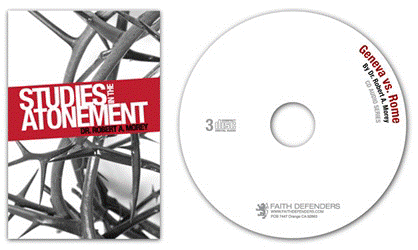
Studies in the Atonement
Dr. Robert Morey demonstrates the forensic or judicial nature of justification with clear, scriptural proof. He lists over twenty references illustrating the forensic nature of justification.
This book reveals why justification is needed and how it is the backbone of the Gospel. It shows how a Holy God is able to be just
and yet justify sinners at the same time.
There are many helpful charts found in the book which clarify and illustrate different aspects of the atonement. The Trinitarian emphasis of this book is evident. Salvation is presented as planned by God the Father, accomplished by God the Son, and applied by
God the Holy Spirit, blessed God, Three in One. See new book on the atonement located at Xulon Press (or click the left bar picture) https://www.xulonpress.com/bookstore/bookdetail.php?PB_ISBN=9781612157542&HC_ISBN=
Geneva vs. Rome
Dr. Morey versus Dr. Fastiggi. In this debate that was originally captured on video, Dr. Morey defends the Reformation principles of Sola Scriptura, Sola Gratia and Solus Christus. It is the Reformation versus Roman Catholicism.
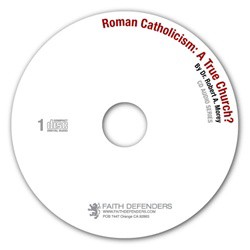
Roman Catholicism: A True Church?
Is the Roman Catholic Church really a true church? Do they really believe the same things Protestants do? This lecture will bring out the truth of the Catholic Church's false teachings.


























